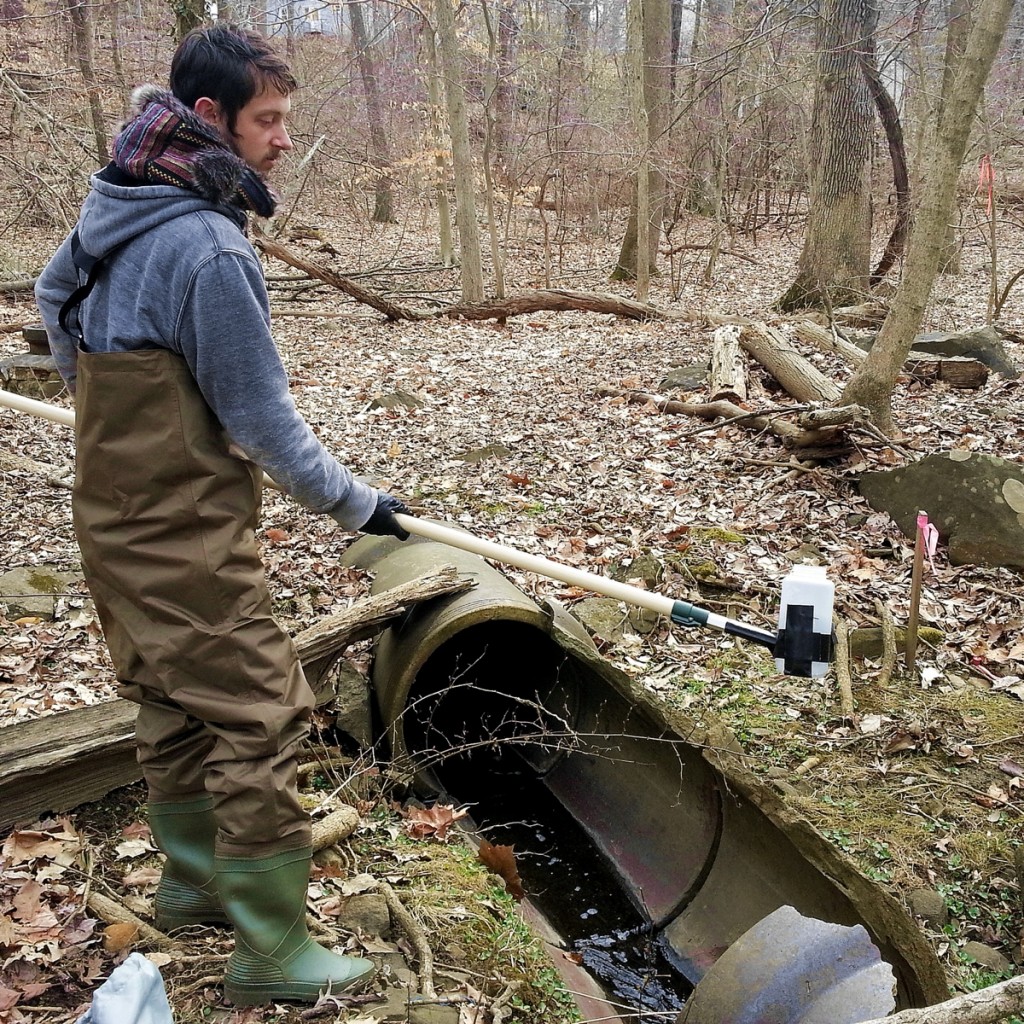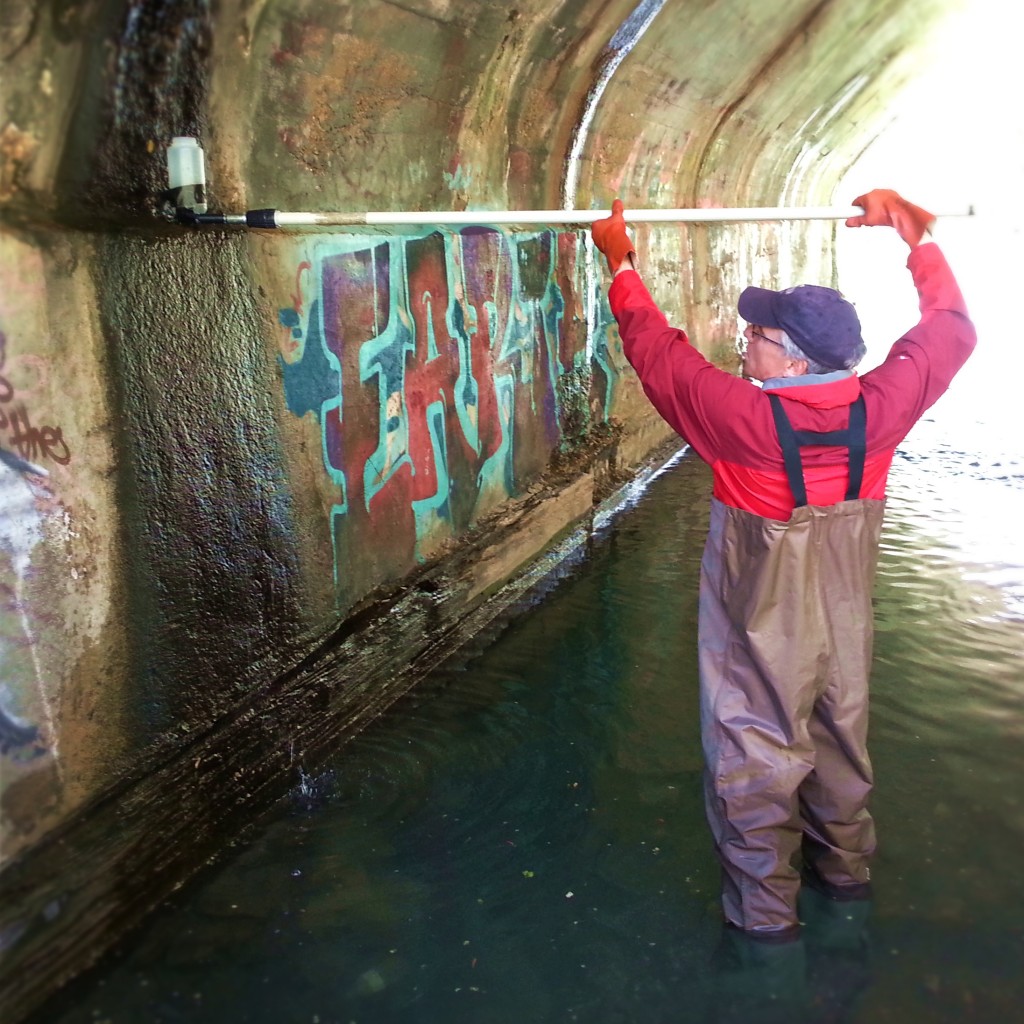How Outfall Screening Can Make Streams Safer
 Imagine you are out kayaking in the Gwynns Falls on a hot and sunny day in mid-July.
Imagine you are out kayaking in the Gwynns Falls on a hot and sunny day in mid-July.
It hasn’t rained in a week, yet somehow as you paddle past a large stormwater outfall you see a steady flow of water discharging into the river.
Would you think this is strange?
After all, it has been really dry lately. Curious to figure out what’s going on, you head in closer to investigate. As you get closer, you notice the water is a bit cloudy and the pipe has dark stains along its bottom. At about that time, the wind changes direction and you catch a whiff of a foul, but almost sweet, odor emanating from the outfall pipe.
What is the mystery water, and where is it coming from? The discharge could be a natural spring or firefighting runoff, or it could be an illicit discharge.
The Municipal Separate Storm Sewer System (aka “MS4”) is intended to convey only rainwater runoff, natural groundwater springs, and the runoff associated with firefighting and other routine activities. In the scenario described above, the discharge couldn’t possibly be rainwater runoff since it had not rained in over a week.
Illicit discharges can originate from a number of different sources including broken sewer lines leaking into stormwater pipes, broken drinking water pipes leaking into stormwater pipes, and illegal connections from commercial or residential properties. The problem is, the stormwater system discharges directly into our local rivers and streams, completely unfiltered and untreated.
The expected functional life of a wastewater sewer pipe is 75 years. In many parts of city the wastewater pipes are over 100 years old and that unfortunately means that leaks and failures are common. Sewage leaks pose a huge health risk for anyone that comes in contact with them, and they contribute to environmental degradation and eutrophication due to the high nutrient content of raw sewage.
 Although drinking water is safe for human consumption because it contains chlorine and fluoride, these chemicals are known to be toxic to some aquatic organisms. Illegal connections to the stormwater system are the most frustrating of all illicit discharges because they are completely avoidable.
Although drinking water is safe for human consumption because it contains chlorine and fluoride, these chemicals are known to be toxic to some aquatic organisms. Illegal connections to the stormwater system are the most frustrating of all illicit discharges because they are completely avoidable.
Either intentional or accidental, illegal connections are made when wastewater sewer lines are connected directly into the stormwater system rather than the wastewater system.
Illicit Discharges cause significant damage to our local waterways and are one of the main pollution sources that we aim to eliminate.
The Baltimore Harbor Waterkeeper, a program of Blue Water Baltimore, has developed a program to investigate dry weather discharges from the stormwater system.
The Outfall Screening Blitz is two-part study – conducted by our staff, interns, and volunteers – consisting of a field investigation followed by a laboratory analysis of suspect water samples. Events are held during dry weather in order to eliminate the chance that a discharge is merely rainwater runoff.
The field portion consists of staff led teams of volunteers walking a half-mile stream stretch and cataloging every stormwater outfall that they encounter.
Whether there is a discharge or not, every outfall is documented. If there is a discharge present, a sample is collected and the flow rate is estimated. For the laboratory portion, volunteers use six water quality instruments to test their samples for ammonia, potassium, fluoride, optical brighteners, surfactants, and turbidity.

Ammonia and potassium are indicators of sewage or wash water contamination. Fluoride is an indicator of drinking water contamination. Optical brighteners and surfactants are chemicals found in detergents and are often associated with illegal connections from laundry mats or commercial carwashes. High turbidity can indicate improper sediment control on construction sites.
If any of the samples exceed the legal threshold for what is considered to be an illicit discharge we report it to the State and local jurisdiction.
We have already investigated the Powder Mill Run and portions of the Herring Run in Baltimore City and Baltimore County. So far, we’ve have encountered 49 outfalls in total, and 12 of those outfalls have tested positive for an illicit discharge contamination.
Yesterday, we worked with students from Morgan State University on May 22nd to screen the section of the Herring Run the flows through their campus. We hold both weekday and weekend blitz events, and we are always looking for more volunteers.
If you are interested in participating, our next training will be held on June 7th. Sign up on our website to join in and join us in protecting Baltimore’s waterways from pollution.
